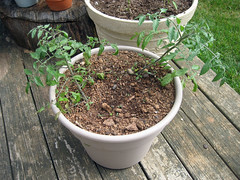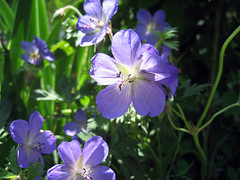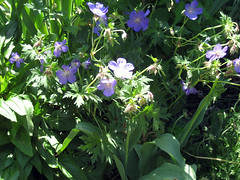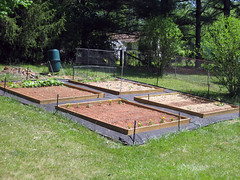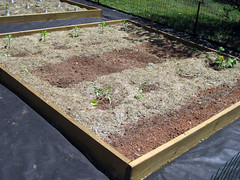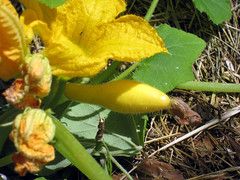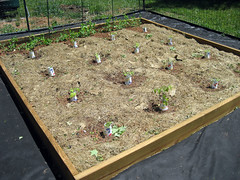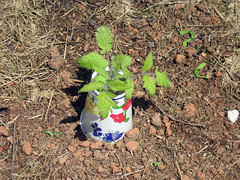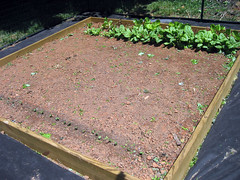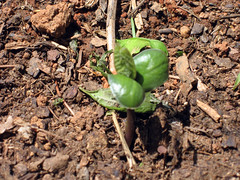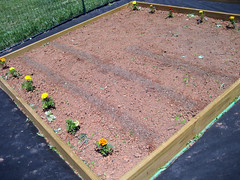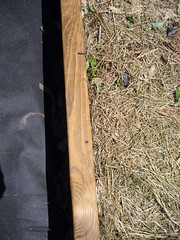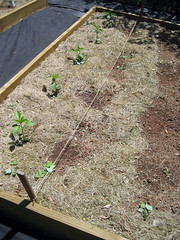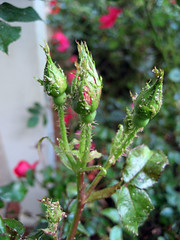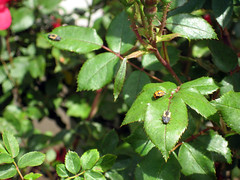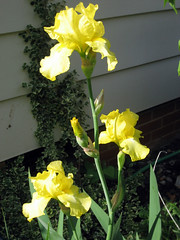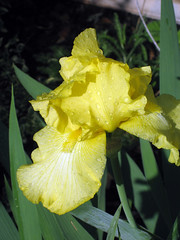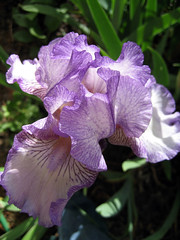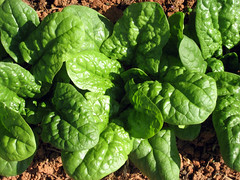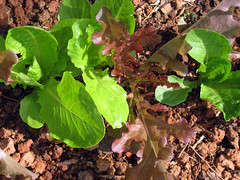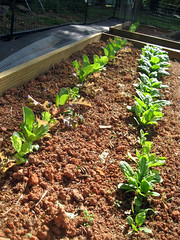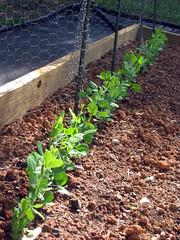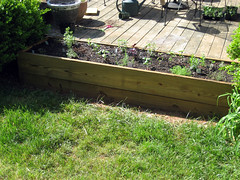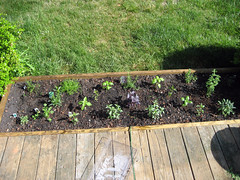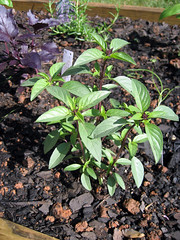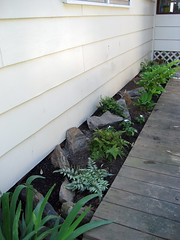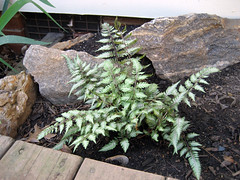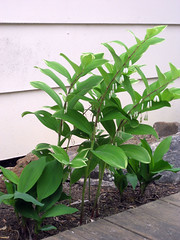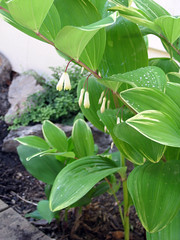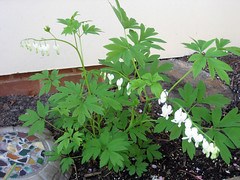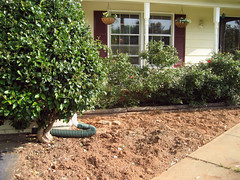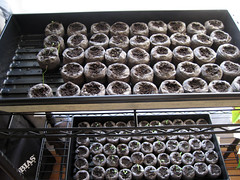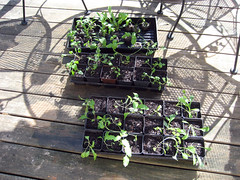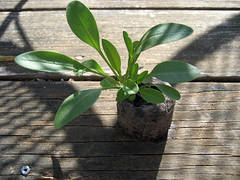Although it rained this past Saturday, I was not deterred by the inclement weather, but managed to get most of my containers planted for Spring and Summer. I gained much inspiration from the
Biltmore Estate's beautiful containers and the book
Containers from my friend
Punchy.
Last year I planted
Limoncello Petunias in my hanging baskets. I had grown the petunias from seed, but I was not impressed with the plants or the arrangements. This year I decided to be a little more bold and try to create a
Proven Winners arrangement worthy of blogging about. I found a slew of Proven Winners flowers at the Horticulture Society plant sale at the Farmer's Market and chose purple, white and yellow annuals to complement the perennial planting combination in the front flowerbox. The flowers for each basket cost about $14.
Priscilla Supertunia is a lavender double-flowering petunia with dark purple veins.
Yellow Chiffon Superbells brings non-stop color from Spring until frost.
Giant Snowflake Snowstorm provides lush green foliage dappled with sweet little white blooms reminiscent of strawberry flowers. The plants are still small, but I am confident they will fill out the baskets beautifully by the end of May, especially once I start hitting them with some Miracle Grow once a week. I planted Proven Winners superbells last year in one of my other containers and was happy with the results.

I really like the soft airy flow of these arrangements and the contrast of the dark purple against the yellow and white.
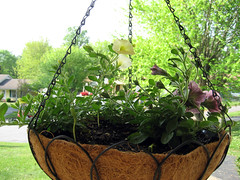
As a side note, I could not find adequate replacement coconut liners this year for my hanging baskets and had to purchase new baskets altogether. The only replacement liners I could find in stores are the non-molded flat round liners that look really crappy when you try to cram them in the basket, because they overlap and look bulky and unprofessional. We can't be having unprofessional looking baskets on my front porch! Furthermore, when these liners get wet, they fray and fall apart. In past years, Lowes and other stores have sold the
replacement liners that are molded to fit the baskets perfectly. Next year I will buy them on-line!
My smaller side window box is a bit less interesting this year but will serve an important purpose - helping to keep aphids off the roses! I planted yellow coreopsis and orange nasturtium in this box. The coreopsis brings nice height to the center of the arrangement, and the nasturtium will cascade over the sides to provide some additional interest. I love the modeled foliage of these nasturtium. Furthermore, aphids LOVE nasturtium, and I am hoping these plants will act as a decoy to keep aphids away from the roses. I am getting tired of spraying down those roses already, and it's only May! This planting cost about $10 total.
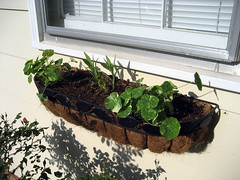
My two cement planters on the front porch get a little bit of morning sun, but enjoy the cool shade for the majority of the day. In the past, I positioned these planters at the front of the porch, but I decided to move them back against the wall this year since the roses have grown to be so large. I like the new position.
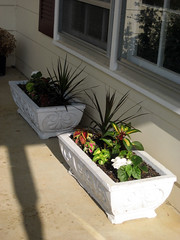
I chose white begonias, orange (new guinea) impatiens, (wizard's mix) coleus and draceana for this planting. The begonias will cascade over the side of the box, bringing a full lush display of glossy green foliage and large white flowers. The impatiens will not only provide lovely orange blooms but add some interest with their multi-colored foliage and red veins that helps complement the habit and color of the dracaena. The dracaena (the spikey plant) adds a tall focal point to the planting, and the multi-colored coleus helps tie the colors and varying habits of the other three plants together. All of these plants are still very young and small and will eventually fill in the box to the point of overflowing. I was concerned that these two boxes are too disjointed from the style of the roses and other containers, but I decided I really like this contrast. Continuity is important, but you have to add a little spice to keep people on their toes too! The plants for each of these containers cost about $7.
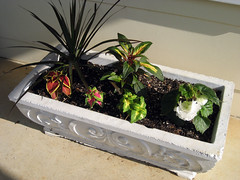
The three-tiered planter is sporting calamintha in the top tier, pink and white double petunias in the middle tier and strawberries in the bottom tier. Although we did not get much fruit from our strawberries last year, I just had to try again! Besides, these plants were only $1 each at the Farmer's Market, so I couldn't help myself. The plants for this container cost about $15.

I also put together an arrangement on the back porch with coleus, sweet potato vine and black elephant's ear, but the elephant's ear bulb has not emerged yet, so the planting is pretty boring to look at.
I had a great time working on these containers and was proud of myself for not spending *too* much money on the plantings. I found some great deals at the Farmer's Market, Lowes and a cute little garden center in Fletcher that I look forward to visiting again soon. I am trying to be economical, but I don't want to trade off quality for value, because poor quality plants are never a good value. Beware of Lowes. Although I do buy some plants there, I do so sparingly when I cannot find what I am looking for at *real* garden centers. There is a noticeable difference in quality between plants purchased from Lowes (or any other department store; ie, Home Depot, Wal-Mart, etc.) and plants purchased from a real garden center.
Labels: "container gardening", "flower box", asheville, gardening
